Context: Understanding Essential Elements for Successful Teamwork
Collaboration is key to accomplishing a collective outcome; for instance, an IT program has many team members, and a team leader needs to foster collaboration and deliver the collective outcome. Teams are formed on the basis of individual skills needed for accomplishing the outcome and not necessarily on the basis of team members’ ability to work in teams or their skills pertaining to basic aspects like goal setting, planning, communication, and trust; these aspects become critical to teamworking and collective success.
Collaborative work is essential across all organizations and needs attention to avoid factors such as overdependence on a dominant leader, lack of delegation, and so on. Collaborative work also allows these factors to be dealt with to improve collective effectiveness when teams intentionally focus on identifying and learning. It is normal to expect a leader to envision the final outcome and set out the plan to realize it. Engaging available resources to accomplish the plan and realize the vision involves multiple processes, for example defining the goals, planning resources, innovating within constraints of time, communicating, and steering progress. Each leader engages differently and so does each of the members in the team; this supports the entire journey of turning vision into reality.
Around 1999, I attended a leadership development program held outdoors. During the course of the program, we were made to play many competitive team-based games. One of such game was a leader guiding a blindfolded team to erect a tent made from cloth, sticks, and rope. Initially, we were all blindfolded and the leader was taken to the spot, at a different location, where material for the tent was placed. The leader was instructed that he couldn’t give any clue or guidance to the team till they were at the spot, and he was also supposed to stay outside the work area; that is, during the activity of tent erection, he was supposed to provide only verbal guidance or instruction without physically participating himself. I was one of the blindfolded team members and our leader asked us to make a human chain and then he navigated us to the spot where we were to touch-’n’-feel, and under his guidance, work. Our team won this game with an extraordinary lead over competing teams. During analysis of the factors that contributed to winning, communication between leader and team members and among team members was identified as one of the key factors, since most of the members of the competing team chose to follow the leader’s instructions and did not even discuss, inquire about, or challenge any of the instruction. The game had given me real-life experience about how communication has an extraordinary influence on teamwork and also about how team members play crucial roles in supporting leadership and contributing to the collective outcome.
Learning and experience from this game are at the core of the game that is explained in this chapter. The game simulates an environment that facilitates experiencing the factors that influence the outcome of a collective work. Examples of collective work include a software solution implementation program, an infrastructure project, or any teamwork in general that engages a large number of individuals as team members and is led by a program director or a project leader. The team bears responsibility for execution of the tasks, while the leader owns the responsibility for managing and achieving the envisioned outcome or end state.
The first time I had conceived this game was for an engagement in which I was assigned to deliver a training session on ERP to a group of very senior people belonging to a company that was embarking on an IT-led transformation by implementation of ERP. The activity was to facilitate identifying and understanding the critical success factors for the ERP program. The game generated the desired result. I later applied the core concept of the game in a variety of contexts and situations, for example to a class of students wanting to learn project management and to a group of CIO’s in a management development program.
Let us now consider the procedure for the Blindfold Game (beginning with preparation, obtaining required materials) and how to conclude by examining the learnings from this game.
Activity
The Blindfold Game is a competitive team game. The game requires a good space, like a lecture hall with space for movement. Volunteers from the participants are invited to form two teams of four participants each and among them they are asked to choose their respective leaders. Both the teams are moved outside the hall so that the activity space is prepared for the game. Each of the team members is blindfolded outside the hall, and the activity space inside the hall is arranged with table, chairs, jug, and glasses in the center of the activity space. The leader of one of the teams is ushered in while the blindfolded team is kept outside. The leader is shown the arrangement of the table, chair, jug, and glasses, that he and his team needs to accomplish. The leader is then explained the rules of the game and specifically reminded that he or she cannot enter into the activity space and that he or she can’t help any of the team members in the activity space. The table, chair, jug, and glasses arrangement is dismantled and these articles are moved to locations outside the activity space. Once leader signals his or her readiness, his or her team is ushered in and the timekeeper starts to measure the time. The blindfolded team members, under instructions of their leader, perform tasks assigned and accomplish the desired arrangement of the table, chairs, jug, and glasses; as they complete the arrangement, a timekeeper reports the time taken. The process repeats for the second team in the same sequence. After the second team accomplishes the arrangement, differences between the time taken and how the leaders and team performed are analyzed and learning is consolidated.
The game begins by moving both teams outside the hall. Then the leader of the first team is invited into the hall, and the instructor explains the task and rules (Figure 4-1).
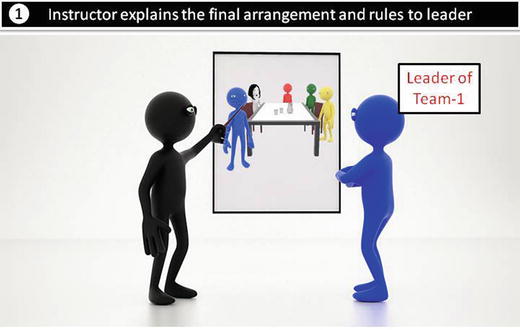
Figure 4-1. Explanation of end state
The members of the first team are blindfolded outside the hall (Figure 4-2).

Figure 4-2. Team members blindfolded
The members of the first team are helped move into the hall and handed over to the leader, and the instructor signals to start timing (which continues until the end state of the arrangement is accomplished) . The leader starts sharing plans and tasks to be performed (Figure 4-3).
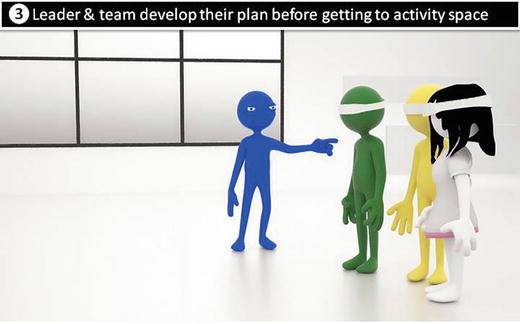
Figure 4-3. Team leader explains the task to the team members.
The team members begin performing the task while the leader guides progress and instructs from outside the activity space (Figure 4-4).

Figure 4-4. Team members begin performing tasks.
The team accomplishes part of the task under the leader’s guidance (Figure 4-5).
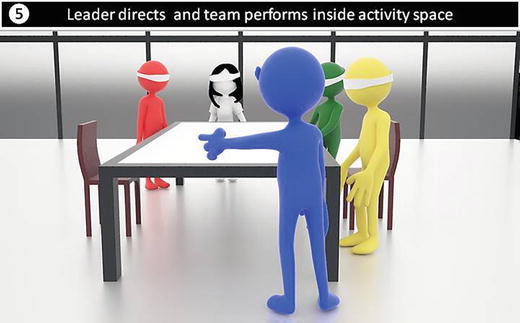
Figure 4-5. Leader instructs and team performs
The timer is stopped as soon as the team completes the arrangement. Their blindfolds are then removed (Figure 4-6).
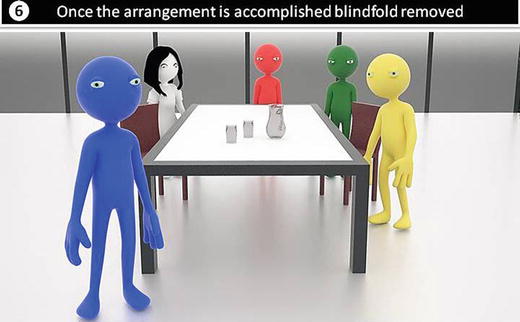
Figure 4-6. Blindfolds are removed after task is complete.
The same process is repeated with the second team. After the second team completes the task, the times are announced. The team that took less time is pronounced the winner.
The instructor now begins to record the experience—observations of the leaders, team members, and observers—to bring about learning from the experience (Figure 4-7).
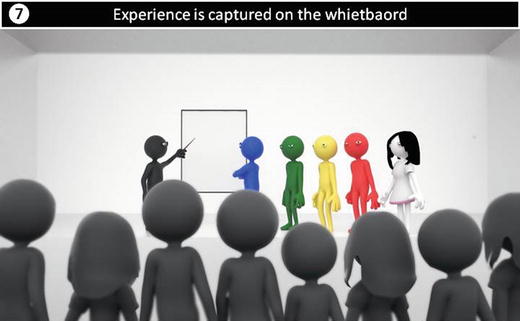
Figure 4-7. Experience and observations captured
An overview of the entire process is depicted in Figure 4-8.
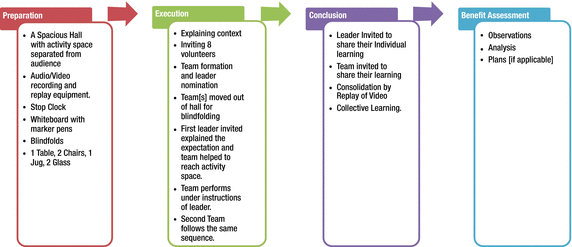
Figure 4-8. Blindfold Game
Process Flow
Complete details of the activities in the process flow are described in detail in the following sections .
Preparation
The game needs arrangement and preparation to ensure that learning is facilitated. The following arrangements and preparation are recommended:
The game needs a spacious hall that can accommodate an activity space that is unhindered by the observer sitting area; especially, the game area should be easy and safe for free movement of blindfolded people.
The activity space within the hall is segregated and identified specifically in such a way that all the observing participants are able to have direct visibility of the minutest movements as well as all communication that takes place among the team participants.
A sufficient number of blindfolds for team members who will participate in the game is needed. The blindfolded participants can be provided with helmets and safety equipment (if needed) to avoid any mishaps during the game.
A lightweight table with two lightweight chairs along with a plastic jug half-filled with water and two plastic glasses are required for the game. Each of these articles should be light, as they will be moved by blindfolded persons and are likely to cause problems if they are heavy or breakable.
A stopwatch for recording the time taken by the teams during the game is also needed.
Audio and video recording and playback arrangements are essential to facilitate the consolidation of learning, especially for the blindfolded participants; the audiovisual equipment should capture even the minutest movements and interactions during the Blindfold Game.
A whiteboard with marker pen is required for making notes during the game as well as during the learning consolidation phase.
Each participant should have notepad and pen to capture learning from observations .
Execution
Once all the preparation is complete, the game can begin.
Preactivity Briefing
One of the important factors for channeling learning from experience is to orient participants to the context; I recommend telling a relevant story before initiating them to the activity. In helping the participants relate to the context of leadership and teamwork, highlight how the leader has a vision of the end state or goal in mind, while team members usually have to be focused on executing the task at hand and most of the time do not focus on the outcome of the collective work.
Invite eight volunteers to play the game.
Help the volunteers to form two teams and facilitate nomination of a leader within each of the teams.
Name the two teams and create their scoring charts on one of the whiteboards.
Request all other participants (i.e., observers) to be extremely observant of and sensitive to each and every element of the experience they will observe and to note these observations in their notepads. The request to keep mental notes on the experience is stressed upon for the two leaders and the team members.
Caution all the observing participants about maintaining absolute silence while two teams compete with each other in the activity space .
Activity
Send both teams out of the hall so that they will not be able to discern the configuration of material in the activity space.
Arrange the articles (table, chairs, jugs, and glasses) in their desired state in middle of the activity space. See Figure 4-9.
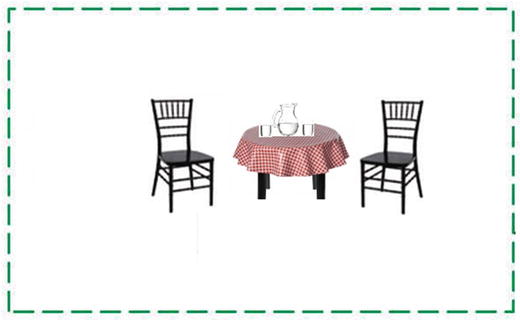
Figure 4-9. End state of arrangement
Now nominate volunteers for performing the following:
A timekeeper job to run the stopwatch.
A monitor to ensure that blindfolding for the team members is done properly and that there has been no prior preparation or planning by either of the teams. The monitor also helps the blindfolded participants during their movement from outside to the activity space inside the hall and ensures the safety of blindfolded participants in general.
Invite one of the team leaders inside the hall and show the end state of the table, chairs, jug, and glasses in the middle of the activity space.
Explain following rules to the leader:
The leader cannot physically perform any of the tasks.
The leader can choose any language or verbal means to communicate with the team members.
The leader can formulate a strategy for ensuring completion of the desired state.
Once the leader acknowledges readiness to start the game, dismantle the end state and keep articles outside of the activity space so that it will be necessary for team members to move them into the desired arrangement state (Figure 4-10).

Figure 4-10. Initial state of articles to be arranged
Advise the monitor to get the team members into the hall and hand them over to the leader and signal to the timekeeper to start the stopwatch.
Ensure that audio/video recording equipment records each of the activities being performed by the team in the game.
The leader starts guiding team members with tasks; once the desired arrangement state is accomplished, check with the timekeeper and record the elapsed time on the whiteboard.
Blindfolds of the performing team members are removed, and each of them (including the leader) is asked to record their experiences while accomplishing the task. This should be done without any discussion among themselves or with other participants.
Now, before the activity is repeated by the second team under identical conditions, observers are specially advised to record their observations on what made the difference between the two teams in achieving the end state.
The leader of the second team is invited to the activity space and given the same instructions that were given to the first leader, and then the second team is invited to the activity space to perform the task under the same conditions as for the first one.
After completion of the activity by the second group, the time taken is recorded on the whiteboard.
After removing the blindfolds, advise each of them (including the leader) to record their experiences while accomplishing the task.
Once the game is over, observations from experience are collected and crystallized in learning in the concluding section.
Conclusion
The difference in the times needed by the teams, form the basic premise, to start collecting observations and analysis for the purpose of generating learning on essential elements for successful teamwork. The recommended process to capture learning from the experience is as follows:
Use the second whiteboard to start recording the elements of learning.
Invite the leader of the losing team to share learnings, which are captured on the whiteboard; the process is repeated with the leader of the winning team.
The process of capturing learning is now repeated for each of the team members from both the teams.
Each of the observer participants is requested to read out loud from his/her notepad and share the top three learnings from the experience. Generally, most learnings are captured early, and participants may repeat many; these repeated learnings should be identified by additional checkmarks next to them. That helps to distinguish more critical learnings from less critical ones (Figure 4-11).
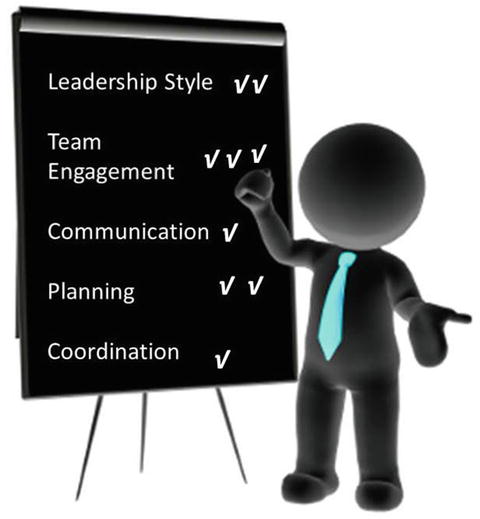
Figure 4-11. Instructor consolidating collective learning
In my experience, learnings differ among groups, since the groups may be composed of anyone from managers in a corporate environment to college students. However, certain elements remain the same, since factors influencing teamwork do not change; only their intensities differ depending on context and environment.
Facilitate participants’ choice of words; for example, interactivity among team members, instructions from the leader, and discussion between team members and the leader all would be identified under a common theme of “ communication,” whether it’s about the quantum of communication or the choice of words or sequence of instructions.
The recorded video is replayed for identifying missing observations and learnings, if any. The replay also helps reinforce and consolidate learnings that were experienced and collected on the whiteboard. Here are sample learning themes that I encountered across most of the sessions:
Leadership style has huge impact on teamwork.
Team engagement is essential for success of teamwork.
Communication is critical aspect of a successful teamwork.
Planning is essential to successfully accomplish a teamwork.
Coordination between team members as well as with leader and team member is pivotal in successful teamwork.
Leader has to maintain a balance of delegation and control for successful teamwork.
Team members’ capability to understand the big-picture while performing his/her task plays crucial role in successful teamwork.
Trust between team is essential element for success of teamwork.
Passion demonstrated by leader and team enhances the probability of success of a teamwork.
After consolidation of the learning, it’s recommended to summarize the observations, and if applicable, track and monitor the gains from application of the gamification.
Sample: Summary Observations
The hallmark of successful teamwork is that the leader is able to get things done and deliver on time and within budget by getting best outcomes from the energy and efforts of team. These successful leaders have common characteristics , and here’s a quick list from my experience:
Illustrates and quantifies the strategy
Communicates effectively
Creates an environment that fosters each team member to contribute to the success of the collective outcome
Uses a participatory decision-making process
Masters the “operational art”
Provides timely alerts as well as rewards and encouragement to the team members
Knows the difference between boldness and recklessness
Benefit Assessment
After consolidation of the learning, it’s recommended to conduct a benefit assessment exercise to measure the gains from application of the game-based approach. Here are some of the recommended assessment methods:
Stakeholder feedback: Team members, peers, and supervisors could be surveyed for feedback about a participant. Many organizations regularly measure employee engagement; a positive change in employee engagement would be another measure of success. Human resource units can measure interpersonal conflict trends. Customer feedback is another measure of how team functioning has improved: “customer” here refers to both direct beneficiaries of the team outcomes (e.g., for a large IT program, the program director is the direct beneficiary of the individual project teams) and indirect beneficiaries (e.g., the CIO of the client company for the IT program being delivered by a service delivery vendor).
Results: Measure impact on real-world production; for example for an IT project, it would be defect level, on-time delivery, on-budget delivery, and so on.
